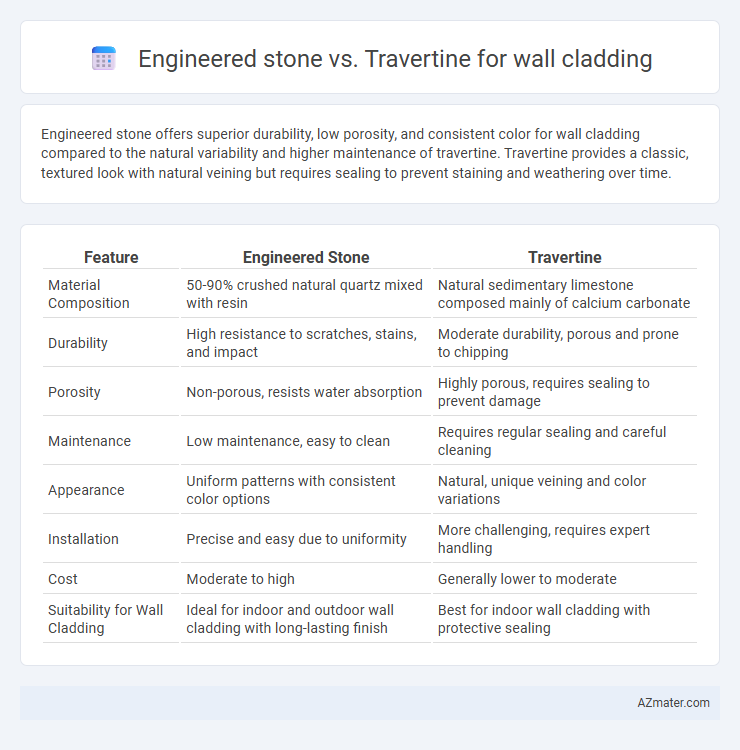Engineered stone offers superior durability, low porosity, and consistent color for wall cladding compared to the natural variability and higher maintenance of travertine. Travertine provides a classic, textured look with natural veining but requires sealing to prevent staining and weathering over time.
Table of Comparison
| Feature | Engineered Stone | Travertine |
|---|---|---|
| Material Composition | 50-90% crushed natural quartz mixed with resin | Natural sedimentary limestone composed mainly of calcium carbonate |
| Durability | High resistance to scratches, stains, and impact | Moderate durability, porous and prone to chipping |
| Porosity | Non-porous, resists water absorption | Highly porous, requires sealing to prevent damage |
| Maintenance | Low maintenance, easy to clean | Requires regular sealing and careful cleaning |
| Appearance | Uniform patterns with consistent color options | Natural, unique veining and color variations |
| Installation | Precise and easy due to uniformity | More challenging, requires expert handling |
| Cost | Moderate to high | Generally lower to moderate |
| Suitability for Wall Cladding | Ideal for indoor and outdoor wall cladding with long-lasting finish | Best for indoor wall cladding with protective sealing |
Introduction to Wall Cladding Materials
Engineered stone offers a highly durable and low-maintenance option for wall cladding, combining crushed quartz with resin for enhanced strength and uniform appearance. Travertine, a natural limestone, provides a timeless aesthetic with unique textures and color variations, ideal for classic and rustic designs. Selection between engineered stone and travertine depends on desired durability, maintenance requirements, and design preferences in wall cladding projects.
What is Engineered Stone?
Engineered stone is a composite material made from crushed natural stone bound together with resin and pigments, offering enhanced durability and a uniform appearance compared to natural stone. It provides high resistance to stains, scratches, and environmental factors, making it ideal for wall cladding in both interior and exterior applications. Unlike travertine, which is a natural sedimentary rock known for its porous texture and unique veining, engineered stone offers a more consistent color palette and easier maintenance.
Understanding Travertine Stone
Travertine stone, a natural sedimentary rock formed by mineral deposits from hot springs, offers a unique porous texture and earthy color palette ideal for wall cladding in both interior and exterior applications. Its natural veining and pitted surface require sealing to prevent moisture absorption and staining, making maintenance a key consideration compared to engineered stone. While engineered stone provides uniformity and enhanced durability through resin binders, travertine's organic patterns and historical elegance make it a preferred choice for designers seeking a classic, warm aesthetic in architectural wall cladding.
Aesthetic Differences: Engineered Stone vs Travertine
Engineered stone offers a consistent, uniform appearance with a wide range of colors and patterns, making it ideal for modern and sleek wall cladding designs. Travertine showcases natural, earthy tones with unique veining and pitted textures, providing a rustic and timeless aesthetic. The choice between engineered stone and travertine ultimately depends on whether a polished, contemporary look or a classic, textured finish is desired.
Durability and Longevity Comparison
Engineered stone offers superior durability for wall cladding due to its non-porous composition, high resistance to stains, scratches, and impact, making it ideal for high-traffic or moisture-prone areas. Travertine, a natural limestone, has inherent porosity and is more susceptible to chipping, erosion, and weathering over time, requiring regular sealing to maintain its longevity. In terms of lifespan, engineered stone typically outlasts travertine by decades with minimal maintenance, providing a more consistent and long-term solution for wall cladding applications.
Maintenance Requirements for Each Material
Engineered stone requires minimal maintenance due to its non-porous surface, resisting stains and eliminating the need for sealing, making it ideal for low-maintenance wall cladding. Travertine, being a natural, porous stone, demands regular sealing and careful cleaning to prevent staining and damage from moisture, increasing upkeep efforts. Choosing between engineered stone and travertine depends on the desired aesthetic balanced with willingness to invest in routine maintenance.
Cost Analysis: Engineered Stone vs Travertine
Engineered stone generally offers a more cost-effective solution compared to travertine for wall cladding, with prices typically ranging from $40 to $100 per square foot, versus travertine's $50 to $120 per square foot. Maintenance costs for engineered stone are lower due to its non-porous nature, eliminating the need for regular sealing required by travertine. Installation expenses for both materials are similar, but engineered stone's durability and resistance to staining can result in long-term savings.
Sustainability and Environmental Impact
Engineered stone offers greater sustainability by utilizing recycled materials and minimizing quarrying impact compared to travertine, a natural stone sourced through extensive mining that disrupts ecosystems. Its manufacturing process typically produces lower waste and reduces the carbon footprint, making engineered stone a more environmentally responsible option for wall cladding projects. Travertine extraction, transportation, and finishing consume significant energy and water resources, increasing its overall environmental impact relative to engineered stone alternatives.
Installation Process and Considerations
Engineered stone offers a more straightforward installation process for wall cladding due to its uniform size, density, and lightweight properties, reducing labor time and effort compared to natural travertine. Travertine requires careful handling because of its porous and uneven surface, often necessitating sealing and expert cutting to prevent damage and ensure proper adhesion. Considerations include moisture resistance and maintenance, with engineered stone providing enhanced durability and easier cleaning, making it ideal for high-traffic or humid areas.
Which is Better for Wall Cladding: Engineered Stone or Travertine?
Engineered stone offers superior durability, low porosity, and consistent color, making it an excellent choice for wall cladding in high-traffic or moisture-prone areas. Travertine provides natural beauty with unique textures and warm tones but requires regular sealing and maintenance to prevent staining and erosion. For long-lasting, low-maintenance wall cladding, engineered stone generally outperforms travertine in both structural integrity and ease of care.

Infographic: Engineered stone vs Travertine for Wall Cladding
 azmater.com
azmater.com